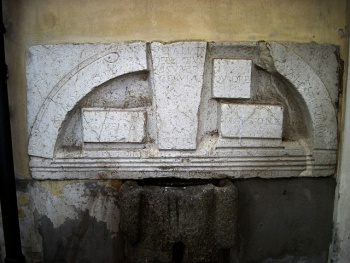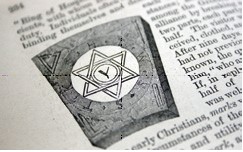Keystone
Keystone
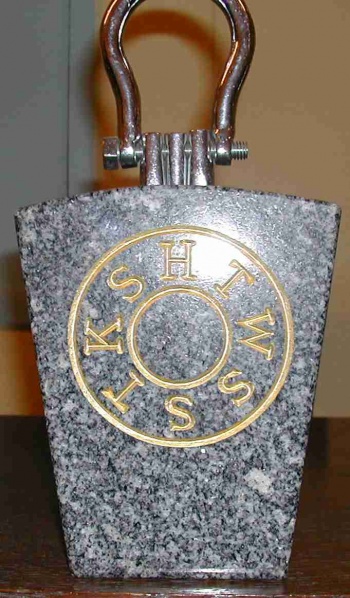
Der "Keystone" oder Schlußstein ist das markanteste Symbol der Royal Arch-Maurerei. Über die Bedeutung der Lettern gibt es zahlreiche, teils verballhornende Interpretationen. Die gängigste ist jedoch "Hiram, Tyrian, Widow's Son, Sendeth To King Solomon ". Als Keystone (engl-), bezeichnet man den zuletzt eingefügten Schlußstein, der das Gewölbe hält. Wird im Royal Arch und in der Markmaurerei symbolisch gedeutet; in letzterer mit den Buchstaben: H. T. W. S. S. T. K. S., die an die Hiramlegende anknüpfen.
Royal Arch Chapter Penny
Bitte übersetzen
This Royal Arch Chapter Penny belonged to Brother Companion Alexander Daniels who was made a Mark Mason in Mount Vernon Royal Arch Chapter in Needham, Mass. The face of the penny bears his Mark... A (thistle) D inside the center of the Keystone. In ancient times your Chapter penny was your most valued possession. It was given as a token of credit when services or money was borrowed and not returned until the debt was fully repaid. It was the "mark" of a mans integrity to keep his word. Very similar to having a credit card in todays world. In its Masonic use, the penny is simply a symbol of the reward of faithful labor.
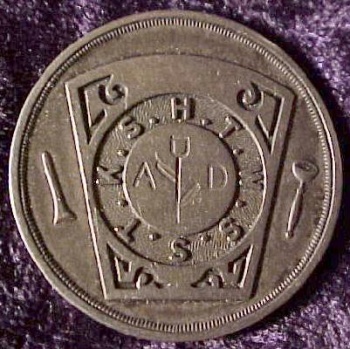
In the parable read in the Mark Degree a penny is the amount given to each of the laborers in the vineyard for his day's labors. This was also the chief silver coin of the Romans from the beginning of the coinage of the city to the earliest part of the third century. Indeed, the name continued to be employed in the coinage of the Continental States, which imitated that of the Byzantine Empire, and was adopted by the Anglo-Saxons. The penny is also found in ancient mythology where it was placed in the mouth of the deceased so that he would have the money to pay his fare to the ferryman when crossing the river Styx on his journey through the underworld.
Quelle: Phoenixmasonry
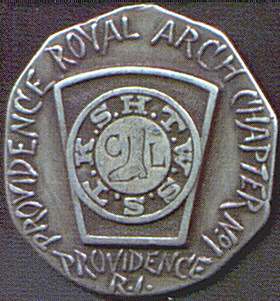
Mark Master Keystone
Bitte übersetzen
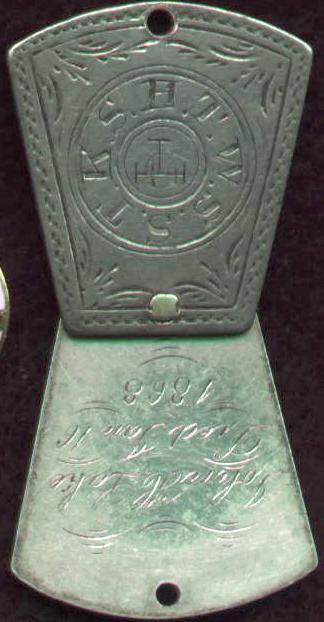
This early sterling silver keystone has a hidden fold-out opening with the engraved names of what appears to be a father and son. It is hand-made and bears the mark of the Triple Tau in the center of the Keystone!
The Mark medal is a sacred token of the rites of friendship and brotherly love which are a solemn obligation of the Mark Master degree. The Mark medal may be pledged for a favor or act of friendship, but must be redeemed before it may be pledged again. Unlike lodge jewels, which were symbols of office, Mark medals were personal possessions retained by Masons, and [they] did not appear in American Masonic usage until about 1795. The Mark medal was worn suspended from the neck by a yellow ribbon, at one time the distinctive color of the Mark degree. The medal was usually made of coin silver or silver plate, although rare examples of gilt copper and even gold are known. On one side was engraved a personal design, or 'mark,' that identified the owner. ... The reverse side bears the owner's name, the name of his Mark lodge, and the date of his exaltation to the degree."
The Tau Cross, or Cross of St. Anthony, is a cross in the form of a Greek T. The Triple Tau is a figure formed by three of these crosses meeting in a point, and therefore resembling a letter T resting on the traverse bar of an H. This emblem, placed in the center of a Triangle and Circle--both emblems of Deity--constitutes the jewel of the Royal Arch as practiced in England, where it is so highly esteemed as to be called the "emblem of all emblems," and "the grand emblem of Royal Arch Masonry." It was adopted in the same form as the Royal Arch badge, by the General Grand Chapter of the United States in 1859. The original signification of this emblem has been variously explained. Some suppose it to include the initials of the Temple of Jerusalem, T. H., Templum Hierosolymae; others, that it is a symbol of the mystical union of the Father and Son, H, signifying Jehovah, and T, or the cross, the Son. A writer in Moore's Magazine ingeniously supposes it to be a representation of three T-Squares, and that it alludes to the three jewels of the three ancient Grand Masters. It has also been said that it is the monogram of Hiram of Tyre; and other assert that it is only a modification of the Hebrew letter shin, which was one of the Jewish abbreviations of the sacred name.

The Keystone was placed in the center of an arch which preserves the others in their places, and secures firmness and stability to the arch. As it was formerly the custom of Operative Masons to place a peculiar mark on each stone of a building to designate the workman by whom it had been adjusted, so the Keystone was most-likely to receive the most prominent mark, that of the Superintendent of the structure. Such is related to have occurred to that Keystone which plats so important a part in the legend of the Royal Arch Degree. The objection has sometimes been made, that the arch was unknown in the time of Solomon. But this objection has been completely laid to rest by the researches of antiquaries and travelers within a few years past. Wilkinson discovered arches with regular keystones in the doorways of the tombs of Thebes, the construction of which he traced to the year 1540 B.C., or 460 years before the building of the Temple of Solomon. And Doctor Clard asserts that the Cyclopean gallery of Tiryns exhibits lancet-shaped arches almost as old as the time of Abraham. In fact, in the Solomonic era, the construction of the arch must have been known to the Dionysian Articifers, of whom, it is a freely received theory, many were present at the building of the Temple. Quelle: Phoenixmasonry

